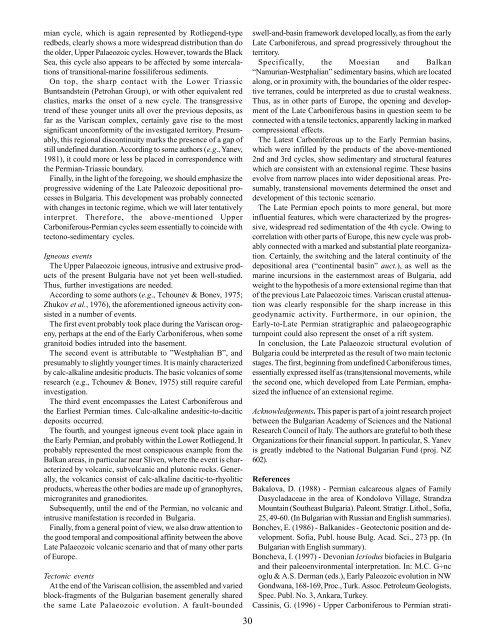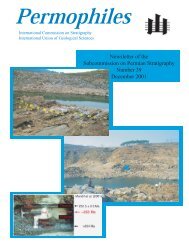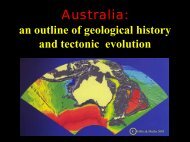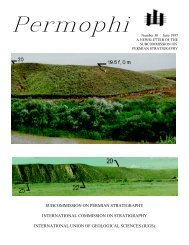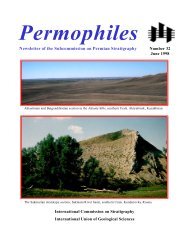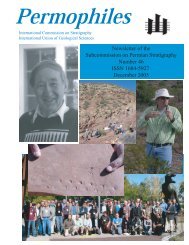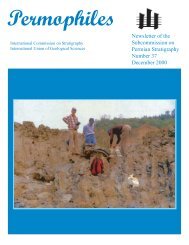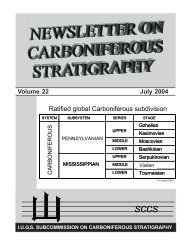Number 31 January 1998 Newsletter of the Subcommission on ...
Number 31 January 1998 Newsletter of the Subcommission on ...
Number 31 January 1998 Newsletter of the Subcommission on ...
You also want an ePaper? Increase the reach of your titles
YUMPU automatically turns print PDFs into web optimized ePapers that Google loves.
mian cycle, which is again represented by Rotliegend-type<br />
redbeds, clearly shows a more widespread distributi<strong>on</strong> than do<br />
<str<strong>on</strong>g>the</str<strong>on</strong>g> older, Upper Palaeozoic cycles. However, towards <str<strong>on</strong>g>the</str<strong>on</strong>g> Black<br />
Sea, this cycle also appears to be affected by some intercalati<strong>on</strong>s<br />
<str<strong>on</strong>g>of</str<strong>on</strong>g> transiti<strong>on</strong>al-marine fossiliferous sediments.<br />
On top, <str<strong>on</strong>g>the</str<strong>on</strong>g> sharp c<strong>on</strong>tact with <str<strong>on</strong>g>the</str<strong>on</strong>g> Lower Triassic<br />
Buntsandstein (Petrohan Group), or with o<str<strong>on</strong>g>the</str<strong>on</strong>g>r equivalent red<br />
clastics, marks <str<strong>on</strong>g>the</str<strong>on</strong>g> <strong>on</strong>set <str<strong>on</strong>g>of</str<strong>on</strong>g> a new cycle. The transgressive<br />
trend <str<strong>on</strong>g>of</str<strong>on</strong>g> <str<strong>on</strong>g>the</str<strong>on</strong>g>se younger units all over <str<strong>on</strong>g>the</str<strong>on</strong>g> previous deposits, as<br />
far as <str<strong>on</strong>g>the</str<strong>on</strong>g> Variscan complex, certainly gave rise to <str<strong>on</strong>g>the</str<strong>on</strong>g> most<br />
significant unc<strong>on</strong>formity <str<strong>on</strong>g>of</str<strong>on</strong>g> <str<strong>on</strong>g>the</str<strong>on</strong>g> investigated territory. Presumably,<br />
this regi<strong>on</strong>al disc<strong>on</strong>tinuity marks <str<strong>on</strong>g>the</str<strong>on</strong>g> presence <str<strong>on</strong>g>of</str<strong>on</strong>g> a gap <str<strong>on</strong>g>of</str<strong>on</strong>g><br />
still undefined durati<strong>on</strong>. According to some authors (e.g., Yanev,<br />
1981), it could more or less be placed in corresp<strong>on</strong>dence with<br />
<str<strong>on</strong>g>the</str<strong>on</strong>g> Permian-Triassic boundary.<br />
Finally, in <str<strong>on</strong>g>the</str<strong>on</strong>g> light <str<strong>on</strong>g>of</str<strong>on</strong>g> <str<strong>on</strong>g>the</str<strong>on</strong>g> foregoing, we should emphasize <str<strong>on</strong>g>the</str<strong>on</strong>g><br />
progressive widening <str<strong>on</strong>g>of</str<strong>on</strong>g> <str<strong>on</strong>g>the</str<strong>on</strong>g> Late Paleozoic depositi<strong>on</strong>al processes<br />
in Bulgaria. This development was probably c<strong>on</strong>nected<br />
with changes in tect<strong>on</strong>ic regime, which we will later tentatively<br />
interpret. Therefore, <str<strong>on</strong>g>the</str<strong>on</strong>g> above-menti<strong>on</strong>ed Upper<br />
Carb<strong>on</strong>iferous-Permian cycles seem essentially to coincide with<br />
tect<strong>on</strong>o-sedimentary cycles.<br />
Igneous events<br />
The Upper Palaeozoic igneous, intrusive and extrusive products<br />
<str<strong>on</strong>g>of</str<strong>on</strong>g> <str<strong>on</strong>g>the</str<strong>on</strong>g> present Bulgaria have not yet been well-studied.<br />
Thus, fur<str<strong>on</strong>g>the</str<strong>on</strong>g>r investigati<strong>on</strong>s are needed.<br />
According to some authors (e.g., Tchounev & B<strong>on</strong>ev, 1975;<br />
Zhukov et al., 1976), <str<strong>on</strong>g>the</str<strong>on</strong>g> aforementi<strong>on</strong>ed igneous activity c<strong>on</strong>sisted<br />
in a number <str<strong>on</strong>g>of</str<strong>on</strong>g> events.<br />
The first event probably took place during <str<strong>on</strong>g>the</str<strong>on</strong>g> Variscan orogeny,<br />
perhaps at <str<strong>on</strong>g>the</str<strong>on</strong>g> end <str<strong>on</strong>g>of</str<strong>on</strong>g> <str<strong>on</strong>g>the</str<strong>on</strong>g> Early Carb<strong>on</strong>iferous, when some<br />
granitoid bodies intruded into <str<strong>on</strong>g>the</str<strong>on</strong>g> basement.<br />
The sec<strong>on</strong>d event is attributable to ”Westphalian B”, and<br />
presumably to slightly younger times. It is mainly characterized<br />
by calc-alkaline andesitic products. The basic volcanics <str<strong>on</strong>g>of</str<strong>on</strong>g> some<br />
research (e.g., Tchounev & B<strong>on</strong>ev, 1975) still require careful<br />
investigati<strong>on</strong>.<br />
The third event encompasses <str<strong>on</strong>g>the</str<strong>on</strong>g> Latest Carb<strong>on</strong>iferous and<br />
<str<strong>on</strong>g>the</str<strong>on</strong>g> Earliest Permian times. Calc-alkaline andesitic-to-dacitic<br />
deposits occurred.<br />
The fourth, and youngest igneous event took place again in<br />
<str<strong>on</strong>g>the</str<strong>on</strong>g> Early Permian, and probably within <str<strong>on</strong>g>the</str<strong>on</strong>g> Lower Rotliegend. It<br />
probably represented <str<strong>on</strong>g>the</str<strong>on</strong>g> most c<strong>on</strong>spicuous example from <str<strong>on</strong>g>the</str<strong>on</strong>g><br />
Balkan areas, in particular near Sliven, where <str<strong>on</strong>g>the</str<strong>on</strong>g> event is characterized<br />
by volcanic, subvolcanic and plut<strong>on</strong>ic rocks. Generally,<br />
<str<strong>on</strong>g>the</str<strong>on</strong>g> volcanics c<strong>on</strong>sist <str<strong>on</strong>g>of</str<strong>on</strong>g> calc-alkaline dacitic-to-rhyolitic<br />
products, whereas <str<strong>on</strong>g>the</str<strong>on</strong>g> o<str<strong>on</strong>g>the</str<strong>on</strong>g>r bodies are made up <str<strong>on</strong>g>of</str<strong>on</strong>g> granophyres,<br />
microgranites and granodiorites.<br />
Subsequently, until <str<strong>on</strong>g>the</str<strong>on</strong>g> end <str<strong>on</strong>g>of</str<strong>on</strong>g> <str<strong>on</strong>g>the</str<strong>on</strong>g> Permian, no volcanic and<br />
intrusive manifestati<strong>on</strong> is recorded in Bulgaria.<br />
Finally, from a general point <str<strong>on</strong>g>of</str<strong>on</strong>g> view, we also draw attenti<strong>on</strong> to<br />
<str<strong>on</strong>g>the</str<strong>on</strong>g> good temporal and compositi<strong>on</strong>al affinity between <str<strong>on</strong>g>the</str<strong>on</strong>g> above<br />
Late Palaeozoic volcanic scenario and that <str<strong>on</strong>g>of</str<strong>on</strong>g> many o<str<strong>on</strong>g>the</str<strong>on</strong>g>r parts<br />
<str<strong>on</strong>g>of</str<strong>on</strong>g> Europe.<br />
Tect<strong>on</strong>ic events<br />
At <str<strong>on</strong>g>the</str<strong>on</strong>g> end <str<strong>on</strong>g>of</str<strong>on</strong>g> <str<strong>on</strong>g>the</str<strong>on</strong>g> Variscan collisi<strong>on</strong>, <str<strong>on</strong>g>the</str<strong>on</strong>g> assembled and varied<br />
block-fragments <str<strong>on</strong>g>of</str<strong>on</strong>g> <str<strong>on</strong>g>the</str<strong>on</strong>g> Bulgarian basement generally shared<br />
<str<strong>on</strong>g>the</str<strong>on</strong>g> same Late Palaeozoic evoluti<strong>on</strong>. A fault-bounded<br />
30<br />
swell-and-basin framework developed locally, as from <str<strong>on</strong>g>the</str<strong>on</strong>g> early<br />
Late Carb<strong>on</strong>iferous, and spread progressively throughout <str<strong>on</strong>g>the</str<strong>on</strong>g><br />
territory.<br />
Specifically, <str<strong>on</strong>g>the</str<strong>on</strong>g> Moesian and Balkan<br />
“Namurian-Westphalian” sedimentary basins, which are located<br />
al<strong>on</strong>g, or in proximity with, <str<strong>on</strong>g>the</str<strong>on</strong>g> boundaries <str<strong>on</strong>g>of</str<strong>on</strong>g> <str<strong>on</strong>g>the</str<strong>on</strong>g> older respective<br />
terranes, could be interpreted as due to crustal weakness.<br />
Thus, as in o<str<strong>on</strong>g>the</str<strong>on</strong>g>r parts <str<strong>on</strong>g>of</str<strong>on</strong>g> Europe, <str<strong>on</strong>g>the</str<strong>on</strong>g> opening and development<br />
<str<strong>on</strong>g>of</str<strong>on</strong>g> <str<strong>on</strong>g>the</str<strong>on</strong>g> Late Carb<strong>on</strong>iferous basins in questi<strong>on</strong> seem to be<br />
c<strong>on</strong>nected with a tensile tect<strong>on</strong>ics, apparently lacking in marked<br />
compressi<strong>on</strong>al effects.<br />
The Latest Carb<strong>on</strong>iferous up to <str<strong>on</strong>g>the</str<strong>on</strong>g> Early Permian basins,<br />
which were infilled by <str<strong>on</strong>g>the</str<strong>on</strong>g> products <str<strong>on</strong>g>of</str<strong>on</strong>g> <str<strong>on</strong>g>the</str<strong>on</strong>g> above-menti<strong>on</strong>ed<br />
2nd and 3rd cycles, show sedimentary and structural features<br />
which are c<strong>on</strong>sistent with an extensi<strong>on</strong>al regime. These basins<br />
evolve from narrow places into wider depositi<strong>on</strong>al areas. Presumably,<br />
transtensi<strong>on</strong>al movements determined <str<strong>on</strong>g>the</str<strong>on</strong>g> <strong>on</strong>set and<br />
development <str<strong>on</strong>g>of</str<strong>on</strong>g> this tect<strong>on</strong>ic scenario.<br />
The Late Permian epoch points to more general, but more<br />
influential features, which were characterized by <str<strong>on</strong>g>the</str<strong>on</strong>g> progressive,<br />
widespread red sedimentati<strong>on</strong> <str<strong>on</strong>g>of</str<strong>on</strong>g> <str<strong>on</strong>g>the</str<strong>on</strong>g> 4th cycle. Owing to<br />
correlati<strong>on</strong> with o<str<strong>on</strong>g>the</str<strong>on</strong>g>r parts <str<strong>on</strong>g>of</str<strong>on</strong>g> Europe, this new cycle was probably<br />
c<strong>on</strong>nected with a marked and substantial plate reorganizati<strong>on</strong>.<br />
Certainly, <str<strong>on</strong>g>the</str<strong>on</strong>g> switching and <str<strong>on</strong>g>the</str<strong>on</strong>g> lateral c<strong>on</strong>tinuity <str<strong>on</strong>g>of</str<strong>on</strong>g> <str<strong>on</strong>g>the</str<strong>on</strong>g><br />
depositi<strong>on</strong>al area (“c<strong>on</strong>tinental basin” auct.), as well as <str<strong>on</strong>g>the</str<strong>on</strong>g><br />
marine incursi<strong>on</strong>s in <str<strong>on</strong>g>the</str<strong>on</strong>g> easternmost areas <str<strong>on</strong>g>of</str<strong>on</strong>g> Bulgaria, add<br />
weight to <str<strong>on</strong>g>the</str<strong>on</strong>g> hypo<str<strong>on</strong>g>the</str<strong>on</strong>g>sis <str<strong>on</strong>g>of</str<strong>on</strong>g> a more extensi<strong>on</strong>al regime than that<br />
<str<strong>on</strong>g>of</str<strong>on</strong>g> <str<strong>on</strong>g>the</str<strong>on</strong>g> previous Late Palaeozoic times. Variscan crustal attenuati<strong>on</strong><br />
was clearly resp<strong>on</strong>sible for <str<strong>on</strong>g>the</str<strong>on</strong>g> sharp increase in this<br />
geodynamic activity. Fur<str<strong>on</strong>g>the</str<strong>on</strong>g>rmore, in our opini<strong>on</strong>, <str<strong>on</strong>g>the</str<strong>on</strong>g><br />
Early-to-Late Permian stratigraphic and palaeogeographic<br />
turnpoint could also represent <str<strong>on</strong>g>the</str<strong>on</strong>g> <strong>on</strong>set <str<strong>on</strong>g>of</str<strong>on</strong>g> a rift system.<br />
In c<strong>on</strong>clusi<strong>on</strong>, <str<strong>on</strong>g>the</str<strong>on</strong>g> Late Palaeozoic structural evoluti<strong>on</strong> <str<strong>on</strong>g>of</str<strong>on</strong>g><br />
Bulgaria could be interpreted as <str<strong>on</strong>g>the</str<strong>on</strong>g> result <str<strong>on</strong>g>of</str<strong>on</strong>g> two main tect<strong>on</strong>ic<br />
stages. The first, beginning from undefined Carb<strong>on</strong>iferous times,<br />
essentially expressed itself as (trans)tensi<strong>on</strong>al movements, while<br />
<str<strong>on</strong>g>the</str<strong>on</strong>g> sec<strong>on</strong>d <strong>on</strong>e, which developed from Late Permian, emphasized<br />
<str<strong>on</strong>g>the</str<strong>on</strong>g> influence <str<strong>on</strong>g>of</str<strong>on</strong>g> an extensi<strong>on</strong>al regime.<br />
Acknowledgements. This paper is part <str<strong>on</strong>g>of</str<strong>on</strong>g> a joint research project<br />
between <str<strong>on</strong>g>the</str<strong>on</strong>g> Bulgarian Academy <str<strong>on</strong>g>of</str<strong>on</strong>g> Sciences and <str<strong>on</strong>g>the</str<strong>on</strong>g> Nati<strong>on</strong>al<br />
Research Council <str<strong>on</strong>g>of</str<strong>on</strong>g> Italy. The authors are grateful to both <str<strong>on</strong>g>the</str<strong>on</strong>g>se<br />
Organizati<strong>on</strong>s for <str<strong>on</strong>g>the</str<strong>on</strong>g>ir financial support. In particular, S. Yanev<br />
is greatly indebted to <str<strong>on</strong>g>the</str<strong>on</strong>g> Nati<strong>on</strong>al Bulgarian Fund (proj. NZ<br />
602).<br />
References<br />
Bakalova, D. (1988) - Permian calcareous algaes <str<strong>on</strong>g>of</str<strong>on</strong>g> Family<br />
Dasycladaceae in <str<strong>on</strong>g>the</str<strong>on</strong>g> area <str<strong>on</strong>g>of</str<strong>on</strong>g> K<strong>on</strong>dolovo Village, Strandza<br />
Mountain (Sou<str<strong>on</strong>g>the</str<strong>on</strong>g>ast Bulgaria). Pale<strong>on</strong>t. Stratigr. Lithol., S<str<strong>on</strong>g>of</str<strong>on</strong>g>ia,<br />
25, 49-60. (In Bulgarian with Russian and English summaries).<br />
B<strong>on</strong>chev, E. (1986) - Balkanides - Geotect<strong>on</strong>ic positi<strong>on</strong> and development.<br />
S<str<strong>on</strong>g>of</str<strong>on</strong>g>ia, Publ. house Bulg. Acad. Sci., 273 pp. (In<br />
Bulgarian with English summary).<br />
B<strong>on</strong>cheva, I. (1997) - Dev<strong>on</strong>ian Icriodus bi<str<strong>on</strong>g>of</str<strong>on</strong>g>acies in Bulgaria<br />
and <str<strong>on</strong>g>the</str<strong>on</strong>g>ir paleoenvir<strong>on</strong>mental interpretati<strong>on</strong>. In: M.C. G÷nc<br />
oglu & A.S. Derman (eds.), Early Paleozoic evoluti<strong>on</strong> in NW<br />
G<strong>on</strong>dwana, 168-169, Proc., Turk. Assoc. Petroleum Geologists,<br />
Spec. Publ. No. 3, Ankara, Turkey.<br />
Cassinis, G. (1996) - Upper Carb<strong>on</strong>iferous to Permian strati-


